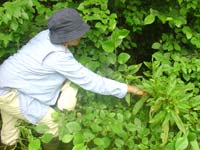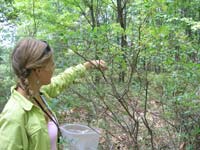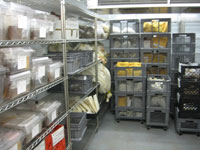The Greenbelt Native Plant Center (GNPC), a facility of the New York City Department of Parks & Recreation, is a 13–acre greenhouse, nursery, and seed bank complex located on Staten Island, NY.
Seed Collecting & Banking
The GNPC’s Seed Collection and Banking Program reflects our mission to grow native plants for New York City projects using only local ecotypes. We collect and store seeds only from native plant populations in the NYC metropolitan region. Healthy populations are sought out as close to home as possible within the 25 counties that cover a 100-mile radius of NYC. This area represents nine counties in New York State including the five boroughs, 14 counties in New Jersey, and one county in Connecticut.

- Our seed collection protocols insure the conservation and sustainability of both existing habitats and restoration sites.
- With the aid of the Royal Botanic Garden-Kew/Millennium Seed Bank Project, we have converted our seed storage facility to meet international standards for Active Seed Banking. The conditions established allow for maintaining seed viability for up to decades at a time and are well suited for seed storage to meet land management needs.
- It is our goal to share our facility with other regional public agencies and non-government organizations (NGOs); we encourage these institutions to bank their seed collections with us in planning for their future land management needs.
The GNPC welcomes area restorationists to use this seed vault for their own native seed banking. We are also available to work with other land management entities to instruct on established procedures for appropriate seed collection.
Please contact Ed Toth, Director, or Tim Chambers, Nursery Manager, to discuss banking your locally collected seeds in our facility as well as other collaborative ventures.
Seed Collection

The overall goal of our seed collection practice is to maximize the genetic diversity both within a population and between populations. The GNPC seed collectors are plant taxonomists who are trained to properly identify species and locate natural populations suitable for collection. Each year plant species that are targeted for collection reflect the projects we are currently serving. We actively communicate with restoration practitioners in the region about their current and future seed needs in order to target our seed collections appropriately.
While continually scouting for new wild populations, the collectors specifically consult with the Brooklyn Botanic Garden’s NY Metro Flora project staff and draw on the knowledge of other local botanists and naturalists to find extant populations.
Specific guidelines are essential for any wild collected seed program:
- Permits are required for collecting species and are obtained from private or government-owned land such as state parks, federal wildlife refuges, and state conservation departments.
- Ideally, a collection is made from at least 50 individuals within a population.
- All collections are labeled in the field with the proper plant name and a detailed field form is completed with important environmental and ecological data.
- Each collection is accessioned and entered into a database, along with the accompanying field data. Then each collection is stored in the seed bank as a separate accession.
Seed Bank

Seed banking at the GNPC is represented by an active, mid-term seed bank with collections used for propagation and storage for future needs. The storage of seed requires desiccation to a certain moisture content, to then be maintained at a stable, reduced temperature and relative humidity. This storage will keep seeds viable for up to a decade, possibly even longer for several species.
- Currently, our seed bank contains approximately 2,600 collections representing 600 species.
- The seed bank is a walk?in cooler fitted with an industrial desiccant dehumidifier.
- The seed bank is maintained at 15 degrees Celsius (59 degrees Fahrenheit) with 15% relative humidity. Seed bank conditions are monitored and recorded.
The seed bank also contains our founder seed collections.
The following websites can be used for further research:
Species Lists/Locations
Brooklyn Botanic Garden NY Metropolitan Flora Project
Botany of the Greater New York City Metropolitan Area
Taxonomic Verification
United States Department of Agriculture Plant Database
State Rare/Listed Species
New York State Natural Heritage Program
New York State Department of Environmental Conservation
New Jersey Natural Heritage Program
Seed Storage Information
Thanks goes to the Royal Botanical Garden at Kew for their funding.